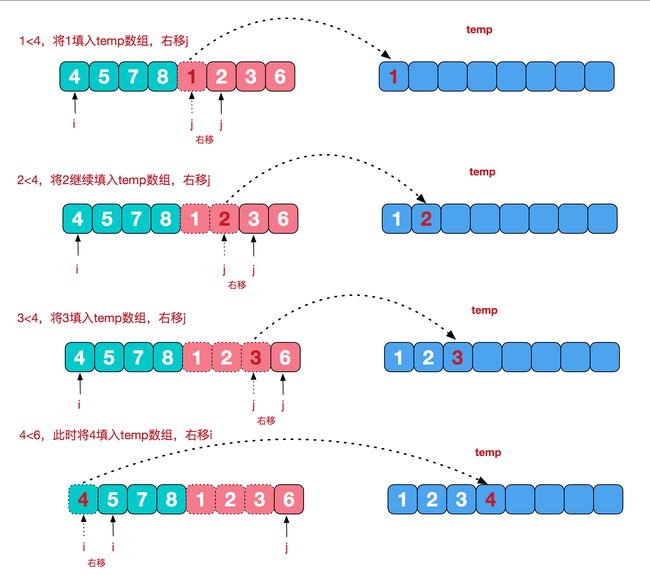排序算法 - 归并排序详解
基本介绍
归并排序(MERGE-SORT)是利用归并的思想实现的排序方法,该算法采用经典的分治(divide-and-conquer)策略(分治法将问题分(divide)成一些小的问题然后递归求解,而治(conquer)的阶段则将分的阶段得到的各答案"修补"在一起,即分而治之)。
基本思想
- 将序列中待排序数字分为若干组,最终每个数字分为一组。(默认长度为1的序列是有序的)
- 将若干个组两两合并,保证合并后的组是有序的。(俩个子序列头部进行比较大小)
- 重复第二步操作直到只剩下一组,排序完成。
归并排序思想示意图
分阶段可以理解为就是递归拆分子序列的过程。

合并相邻有序子序列
再来看看治阶段,我们需要将两个已经有序的子序列合并成一个有序序列,比如上图中的最后一次合并,要将 [4,5,7,8] 和 [1,2,3,6] 两个已经有序的子序列,合并为最终序列 [1,2,3,4,5,6,7,8] ,来看下实现步骤:


代码实现
归并排序的思想主要是利用栈的特性,递归进行分解操作,肯定是从大数组向小数组进行分解。递归进行合并操作,肯定是从小数组向大数组进行合并。
递归详解:https://blog.csdn.net/ZSA222/article/details/124541940?spm=1001.2014.3001.5502
/**
* @ClassName MergeSortDemo
* @author: shouanzh
* @Description 归并排序
* @date 2022/5/9 18:27
*/
public class MergeSortDemo {
public static void main(String[] args) {
int[] array = new int[]{8, 4, 5, 7, 1, 3, 6, 2};
// 归并排序 需要额外的空间
int[] temp = new int[array.length];
mergeSort(array,0,array.length - 1,temp);
System.out.println(Arrays.toString(array)); // [1, 2, 3, 4, 5, 6, 7, 8]
}
/**
* 分加合的方法
* @param array 排序的原始数组
* @param left 左边有序序列的初始索引
* @param right 最右边索引
* @param temp 中转的临时数组
*/
public static void mergeSort(int[] array, int left, int right, int[] temp) {
if (left < right) {
int mid = (left + right) / 2; // 中间索引
System.out.println("分:left=" + left + " right=" + right + " mid=" + mid);
// 左边归并排序,使得左子序列有序
mergeSort(array,left,mid,temp);
// 右边归并排序,使得右子序列有序
mergeSort(array,mid + 1,right,temp);
// 将两个有序子数组合并操作
merge(array,left,mid,right,temp);
}
}
/**
* 合并的方法
* @param array 排序的原始数组
* @param left 左边有序序列的初始索引
* @param mid 中间索引(左边有序序列最后的值的索引)
* @param right 最右边索引
* @param temp 中转数组
*/
public static void merge(int[] array, int left, int mid, int right, int[] temp) {
// 初始化i, 左边有序序列的头部初始索引
int i = left;
// 初始化j, 右边有序序列的头部初始索引, mid + 1
int j = mid + 1;
// 指向中转数组 temp 的当前索引
int t = 0;
// 1. 先把左右(有序)序列的数据按照规则填充到中转数组 temp
// 直到左右俩边的有序序列有一边处理完毕为止
while (i <= mid && j <= right) {
// 左边有序序列头部元素 <= 右边有序序列头部元素
if (array[i] <= array[j]) {
// 将 array[i] 即小的数据 填充到 中转数组 temp, 并将 i 和 t 后移
temp[t] = array[i];
t += 1;
i += 1;
} else {
// 反之 将 右边有序序列头部元素 拷贝到 中转数组 temp, 并将 j 和 t 后移
temp[t] = array[j];
t += 1;
j += 1;
}
}
// 2. 把有剩余数据的一边的剩余数据依次全部填充到 temp
// 2.1 说明左边有序序列还有剩余元素, 将剩余元素全部填充到 temp
while (i <= mid) {
temp[t] = array[i];
t += 1;
i += 1;
}
// 2.2 说明右边有序序列还有剩余元素, 将剩余元素全部填充到 temp
while (j <= right) {
temp[t] = array[j];
t += 1;
j += 1;
}
// 3. 把中转数组 temp 元素 拷贝到 原始数组 array
t = 0;
int tempLeft = left;
System.out.println("合并:tempLeft=" + tempLeft + " right=" + right);
while (tempLeft <= right) {
array[tempLeft] = temp[t];
t += 1;
tempLeft += 1;
}
}
}
运行结果
分:left=0 right=7 mid=3
分:left=0 right=3 mid=1
分:left=0 right=1 mid=0
合并:tempLeft=0 right=1
分:left=2 right=3 mid=2
合并:tempLeft=2 right=3
合并:tempLeft=0 right=3
分:left=4 right=7 mid=5
分:left=4 right=5 mid=4
合并:tempLeft=4 right=5
分:left=6 right=7 mid=6
合并:tempLeft=6 right=7
合并:tempLeft=4 right=7
合并:tempLeft=0 right=7
[1, 2, 3, 4, 5, 6, 7, 8]